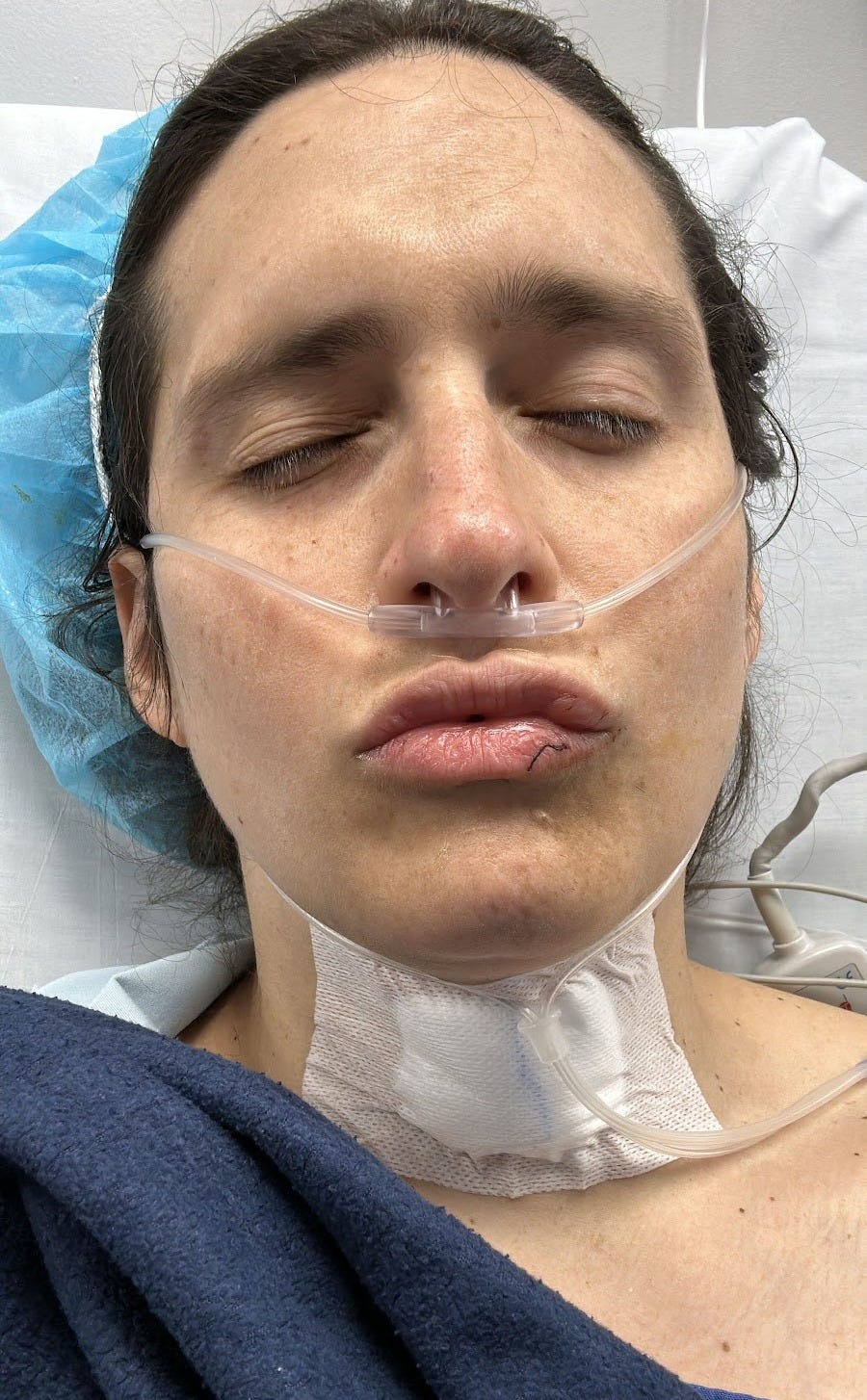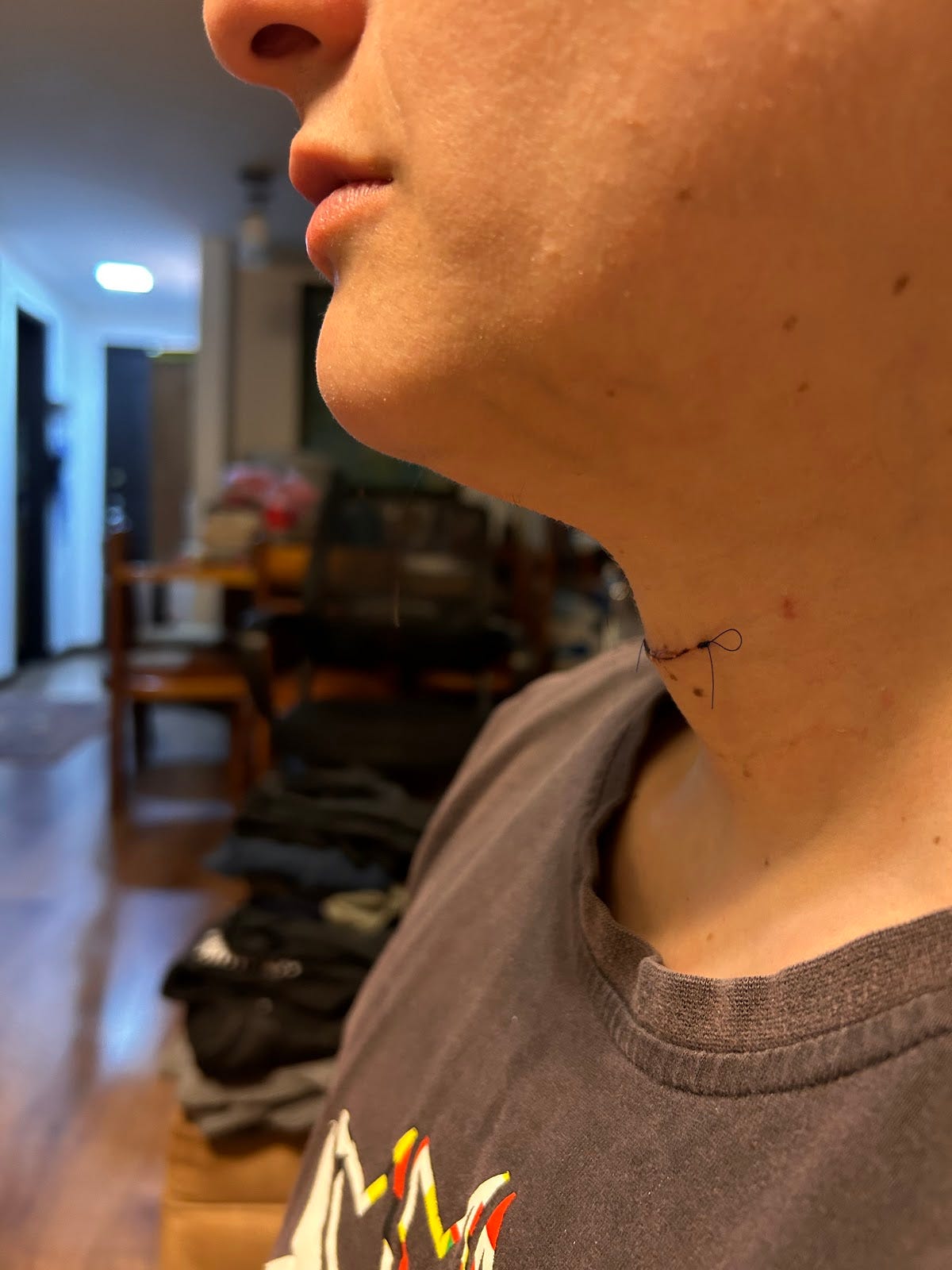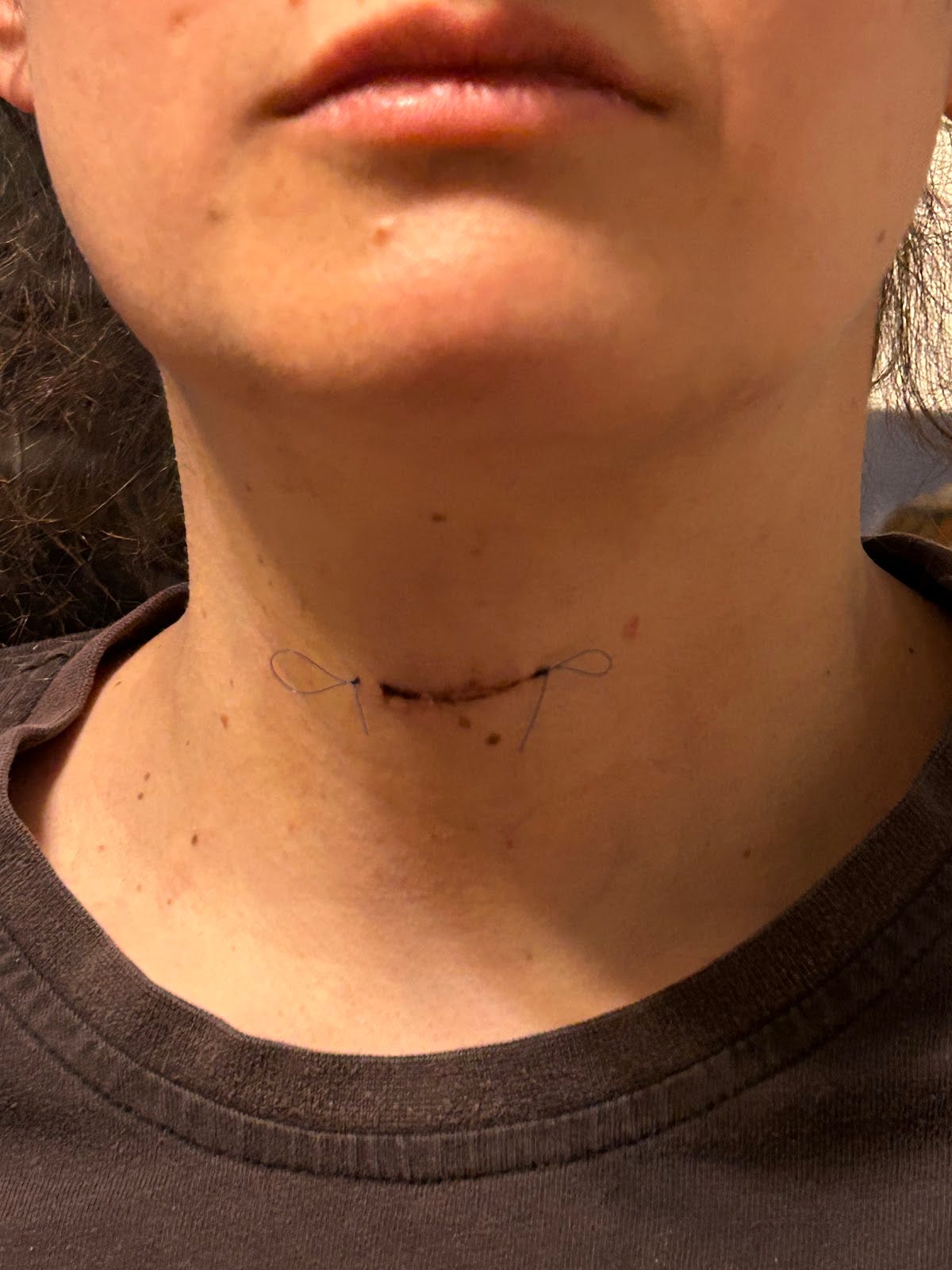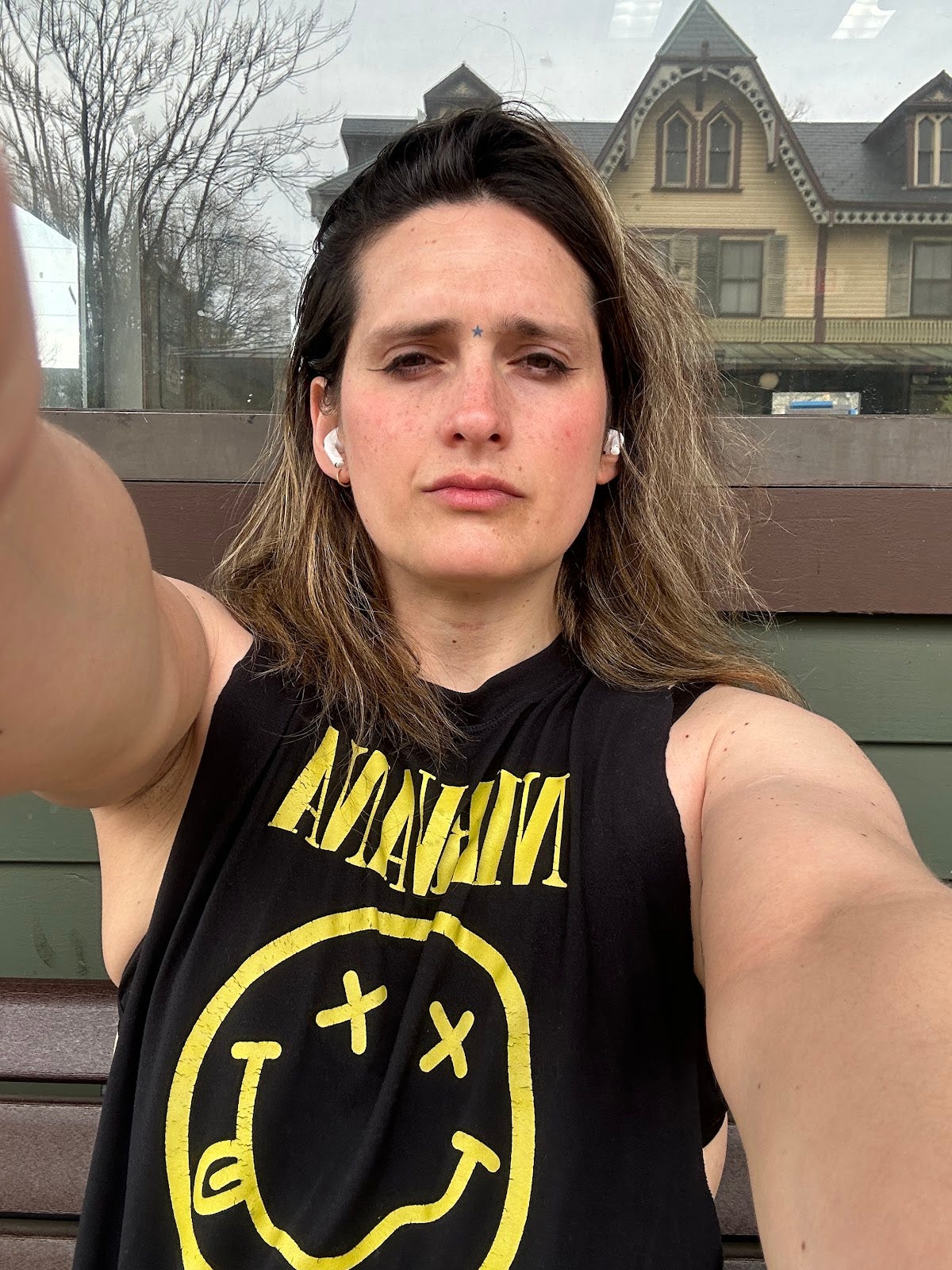As a transgender woman, I’ve never been able to come to terms with having an “Adam’s apple.” So I renamed it: I call it “Eva’s.” After all, it was she who ate the fruit, and how else could it have gotten stuck in there anyway? Still, that wasn’t enough to make me want to keep the cartilage jutting from my throat. So I got rid of it.
I’m going to tell you how it all went down, but before I do so, let me explain why exactly I did it.
Why I Did It
When people ask me about dysphoria, I usually draw from two sources to explain what my brain goes through: the self-image I’ve created when thinking or talking about myself, and the way that image shows up in my imagination and dreams. Dreams—those chaotic pre-dawn movies our minds play—are one of the few opportunities I get to be her without question. There are no mirrors in dreams, no onlookers, no expectations. Just me. And in those dreams, I glide. I’m always elegant, always composed, always effortlessly myself. There is no Eva’s apple. No doubts and no dysphoria. I know this because I have spent years training myself in lucid dreaming.
In my mind, I’m a tubular, sleek, and feminine figure, a version of me that doesn’t match the person I see in the mirror. She doesn’t have an Eva’s apple. And being one of three siblings assigned male at birth, I couldn’t believe how unlucky I was to be the only one with such a prominent lump in my throat. To me—and only me—it screamed masculinity. And not in an abstract way. It was immediate, visceral. A piece of my body betraying my own essence.
So I’d try to mask it. Scarves, turtlenecks, heavy necklaces and chokers—I would actually choke myself with them to try and make my Eva’s apple disappear—anything to hide that bulge. But I lived in Bogotá, and it's not exactly chilly year-round. I would sweat through discomfort and pretend I was “just cold.” I learned the precise angles at which to hold my chin in photos. I contorted myself. I avoided close-ups. I ducked my head when speaking in groups. All because of a piece of cartilage that I never asked for.
I’ve been told, both directly and indirectly, that it's vain to fixate on something so “minor.” But dysphoria is not logical. It doesn’t care what’s “minor.” It only cares that something feels wrong, deeply wrong, and it refuses to let you rest until the problem is “corrected.” Dysphoria takes up space and air. It has weight, and that lump in my neck may as well have been a boulder.
Setting the Stage
In Colombia, transgender people seeking gender-affirming procedures have to jump through a series of hoops. The first one is a mandatory year of psychological therapy, designed to determine whether a person is “confused” or “really” transgender. (Yes, those quotation marks are doing a lot of work.) It’s humiliating in some ways, like pleading guilty and having the judge tell you that you’re lying. I mean seriously, who wants to be trans in the environment this world has created for us? But I did it. I endured every awkward question with a smile, met every microaggression dressed up as “professional assessment” with humor. And I was cleared.
At 31 I began hormone replacement therapy (HRT). That was the real beginning of my life—and not the one everyone else seemed to want me to live.
Those first two years on HRT were magical. Not perfect, but genuinely magical. Every morning I scanned the mirror for signs of her: my real self. Some days I cried tears of joy. On others I stared for hours, wondering if anything was changing at all. But through it all, I was building something. A version of myself that felt right. Every small shift was a victory. Softer skin. Fuller hips. A more pronounced waist. Inflamed nipples that never turned into breasts . . . I didn't care. But that damned Eva’s apple never left. It stood out in my throat like a sign I hadn’t agreed to hold at a protest I didn’t agree to go to.
After two years of social transitioning and a full year on hormones, I became eligible for gender-affirming surgery through the public health system. However, the process was not as simple as that makes it sound. By then a new presidential administration had taken over, and things were moving slower. Getting my appointments was a full-time job that didn’t pay—in fact it wasted money on transport. It was a full-on administrative melodrama. I had to prove my womanhood in a hundred different ways, on paper and in person. And yet I pushed through, because I had to. When something affects your sense of self this profoundly, giving up isn’t an option. Not really.
I scheduled two procedures a month apart. The first one was supposed to be simple—just an orchidectomy (testicle removal). But it went terribly wrong. The complications included pain that made me faint twice, localized fever and long, terrifying nights of sweating and discomfort. It was, in fact, a very close call.
Honestly, I almost didn’t go through with the second procedure—the one that would finally remove that cursed Eva’s apple. But after everything, I couldn’t bring myself to back out. To hell with that; I had come too far.
The day before the surgery, I sat in the surgeon’s office, nervous and sore from everything my body had already been through. He asked how I was feeling. “A bit nervous—you’re about to cut my throat open,” I said.
“No worries. It’s a very simple procedure,” he reassured me. “I’ve done it many times.” He even pulled out his phone and showed me his social media. He wasn’t just any doctor—he was the doctor for pop stars and vocalists across Colombia. If he could finesse the necks of idols who depend on their throats for their work and art, I figured he could handle mine just as well. I guess the system finally came through for me with this one.
The Procedure
“A tracheal shave reduces the prominence of the Adam’s apple,” said the doctor.
“Eva’s,” I corrected.
He didn’t laugh. But he did look confused.
Still, he explained everything clearly. The cartilage would be shaved down carefully, without touching my vocal cords. The risk of voice change was low, but not zero. I nodded. I understood. However, I had honestly convinced myself that I would rather die than keep living as a version of myself that felt like a total lie, some TV character I wasn’t supposed to be playing annymore—that production had ended.
The next morning, I was put on a stretcher by Nas (one of my dearest friends, who then had to leave) and wheeled into surgery. Right before it started, I remember joking with the anesthesiologist that I’d probably be immune after everything I’d been through. He smiled. I blinked. And then he was gone and I was out.
The Healing Process
I woke up groggy, but immediately reached for my neck. Instead of the lump, I felt a soft, cottony patch. A nurse approached, gently squeezing my arm. “How are you feeling?” she asked.
I couldn’t speak for the first few hours, so I just gave a thumbs up.
My friend Erica was waiting for me when I came out—no pun intended. She is one of the few people in my life who never made me feel like a burden during this process. She asked how I was doing. I pointed to my crotch.
“Pipi?” she asked.
Another thumbs up. She laughed and called the nurse.
I went home that day, still groggy but grateful. I had soup, wrapped myself entirely in blankets, watched terrible television, and tried to heal. Day three was when I removed the patch. What I saw underneath wasn’t just the result of a surgery—it was art. A tiny bowtie-shaped stitch. My neck looked elegant, clean, feminine. I sobbed for five minutes straight. I finally saw her. There she was. There I was.
Recovery wasn’t easy, but it was peaceful. I watched YouTube tutorials and science-related skits, ordered too many smoothies, and avoided anything solid for a week. My angel of a mom—who once cried in confusion when I came out—now called every day to check on me and celebrated every second of my victory and my honest smile. Love is strange like that. People change. Sometimes slower than we want, but they do. And even if they don’t, at least I had changed according to my needs and not stayed the same to serve someone else’s.
When I returned to the clinic, two very good-looking nurses greeted me like I was a celebrity. They took photos of my neck and complimented the results. I smiled, still stunned at how such a small change could make a massive difference in how I felt in my own skin. Or under it, I guess.
The doctor came in, checked the incision, and asked a couple questions. I complimented him on how lovely the bowtie-looking stitches he gave me looked. He told me I could keep them for another week. “Everything looks great,” he said.
One week later, they came out. No complications. No regrets. Just joy. The kind that’s quiet, steady, and earned.
Almost the End
These procedures were “free,” technically, provided by the Colombian public health system. I promised the surgeon I’d promote his work on social media to thank him. But I never got the chance.
Someone put a target on my back and I had to flee, remove myself from this person’s sight and stop making him uncomfortable with my presence and my “trans essence.” Or else he would just “smoke me up.”I had to disappear. Delete everything. Go offline. Vanish, like that anesthesiologist did when I joked that he wouldn't be able to put me down.
I couldn’t keep my promise to that awesome surgeon. Not then. But maybe this piece counts as a start.
This surgery changed my life. It reduced my dysphoria by at least 30%. And while the world is still a terrifying hellhole for trans people, at least inside—in that control tower in my head—I can finally see her in the mirror. And she’s beautiful. Not scary…
She’s got a sexy-ass neck, with a very little scar that she takes care of by carefully applying sunscreen every day. She now possesses a laugh that doesn’t flinch, and now that the incisions are healed, it doesn't hurt either.
And when I touch the scar, I don’t feel like life has failed me. I feel truly free.
Guadalupe (she/her) is a 35-year-old trans woman from Colombia, where she was born and raised. She has always had a deep connection to the arts—but it’s through acting and writing that she has grown the most, channeling her passion for self-expression and the exploration of human ego into her work.










